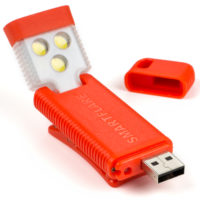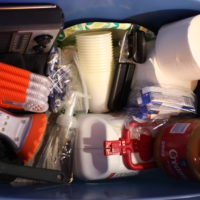Emergency Preparedness Kit: Every Home Should Have One!
SmartFlare LED lights are ideal to keep in your Emergency Supply Kit, with flashlight, lantern and emergency flare modes. They are so much more useful than an ordinary flashlight!
Published on June 14, 2016
No matter where you live, there are possibilities for natural disasters and emergencies. Whether it’s tornadoes, severe thunderstorms, floods, earthquakes or hurricanes, you should be prepared with the essentials to help your family in a disaster and its aftermath. With the help of redcross.org and ready.gov, we’ve gathered some important items to help you build a basic Emergency Preparedness Kit. Keep these items in a storage container with lid where you can easily access it in the event of a natural disaster or emergency.
- Lighting – Lights are essential to have in a disaster, but a basic flashlight can only do so much. SmartFlare LED Combo and SwivelProLED lights have different lighting modes to meet different needs all in one device – LED flashlight mode (for lighting specific areas), LED lantern mode (for lighting larger areas) and flare mode (with super-bright red and white LED flashing lights, which can be used to draw attention to your location if needed). They also have a magnetic base, which proves to be very helpful in an emergency situation. For example, if you are without power, you could either set it on the ground on it’s sturdy flat base or attach it to any metal surface (even upside down), and light up the entire room while keeping your hands free.
- Radio – Battery powered or hand-crank (NOAA Weather Radios are recommended)
- Extra batteries for lights and radio
- Water and Food – Plan for at least 1 gallon of water per person, per day; and at least 3-day supply of nonperishable foods and snacks that do not require refrigeration and cooking. Keep in mind the number of people in your family when you stock up your food supply. Some food suggestions include:
- Canned fruit, vegetables and meats
- Protein bars
- Peanut butter
- Dried fruits
- Nuts
- Canned juices
- Non-perishable pasteurized milk
- Food supplies – Include disposable plates, cups and utensils. And don’t forget a manual can opener!
- First Aid Kit
- Clothing and bedding – include clothing, shoes, socks and warm blankets and/or sleeping bags for everyone in your family. Pack extra items like coats, gloves, hats, etc. if you live in a colder climate area.
- Backpack(s) in case you need to pack critical supplies to go on the move or change locations.
- Sanitation and Hygiene Supplies – include moist towelettes/wipes, toilet paper, disinfecting cleaner or wipes for surfaces, toothbrush/toothpaste, hand sanitizer, washcloths and towels.
- Copies of personal documents, family contact information and extra cash in a waterproof container (documents such as identification, pertinent medical information, proof of address, deed/lease to home, passports, birth certificates, insurance policies, etc.)
- Fire Extinguisher
- Tools such as pipe wrench (for turning off utilities if needed), and multipurpose pliers and utility knife.
- Individual needs of family members – Think through and plan for the individual needs for every member of your family as well as pets (plan for a three day supply). For example: medications/medical supplies, glasses, feminine supplies, baby food and formula, diapers, pet food/water and supplies, if applicable.
You can go above and beyond these basic items to ensure your family is as prepared and comfortable as possible in an emergency situation. For more information and recommendations for a more robust kit, visit redcross.org and ready.gov.
 SwivelProLED™
SwivelProLED™
 LED Combo Light
LED Combo Light
 SwivelClip™
SwivelClip™




